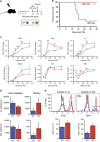Calcium/calmodulin-dependent kinase kinase 2 regulates hematopoietic stem and progenitor cell regeneration
- PMID: 28981105
- PMCID: PMC5680595
- DOI: 10.1038/cddis.2017.474
Calcium/calmodulin-dependent kinase kinase 2 regulates hematopoietic stem and progenitor cell regeneration
Abstract
Hematopoietic stem and progenitor cells (HSPCs) are predominantly quiescent in adults, but proliferate in response to bone marrow (BM) injury. Here, we show that deletion of Ca2+/calmodulin (CaM)-dependent protein kinase kinase 2 (CaMKK2) promotes HSPC regeneration and hematopoietic recovery following radiation injury. Using Camkk2-enhanced green fluorescent protein (EGFP) reporter mice, we found that Camkk2 expression is developmentally regulated in HSPC. Deletion of Camkk2 in HSPC results in a significant downregulation of genes affiliated with the quiescent signature. Accordingly, HSPC from Camkk2 null mice have a high proliferative capability when stimulated in vitro in the presence of BM-derived endothelial cells. In addition, Camkk2 null mice are more resistant to radiation injury and show accelerated hematopoietic recovery, enhanced HSPC regeneration and ultimately a prolonged survival following sublethal or lethal total body irradiation. Mechanistically, we propose that CaMKK2 regulates the HSPC response to hematopoietic damage by coupling radiation signaling to activation of the anti-proliferative AMP-activated protein kinase. Finally, we demonstrated that systemic administration of the small molecule CaMKK2 inhibitor, STO-609, to irradiated mice enhanced HSPC recovery and improved survival. These findings identify CaMKK2 as an important regulator of HSPC regeneration and demonstrate CaMKK2 inhibition is a novel approach to promoting hematopoietic recovery after BM injury.
Conflict of interest statement
The authors declare no conflict of interest.
Figures







Similar articles
-
Inhibition of Ca²⁺/calmodulin-dependent protein kinase kinase 2 stimulates osteoblast formation and inhibits osteoclast differentiation.J Bone Miner Res. 2013 Jul;28(7):1599-610. doi: 10.1002/jbmr.1890. J Bone Miner Res. 2013. PMID: 23408651 Free PMC article.
-
Functional analysis of an R311C variant of Ca2+ -calmodulin-dependent protein kinase kinase-2 (CaMKK2) found as a de novo mutation in a patient with bipolar disorder.Bipolar Disord. 2020 Dec;22(8):841-848. doi: 10.1111/bdi.12901. Epub 2020 Apr 9. Bipolar Disord. 2020. PMID: 32216002
-
Using the fluorescent properties of STO-609 as a tool to assist structure-function analyses of recombinant CaMKK2.Biochem Biophys Res Commun. 2016 Jul 22;476(2):102-7. doi: 10.1016/j.bbrc.2016.05.045. Epub 2016 May 11. Biochem Biophys Res Commun. 2016. PMID: 27178209
-
The Ca(2+)/Calmodulin/CaMKK2 Axis: Nature's Metabolic CaMshaft.Trends Endocrinol Metab. 2016 Oct;27(10):706-718. doi: 10.1016/j.tem.2016.06.001. Epub 2016 Jul 20. Trends Endocrinol Metab. 2016. PMID: 27449752 Free PMC article. Review.
-
The role of CaMKK2 in Golgi-associated vesicle trafficking.Biochem Soc Trans. 2023 Feb 27;51(1):331-342. doi: 10.1042/BST20220833. Biochem Soc Trans. 2023. PMID: 36815702 Free PMC article. Review.
Cited by
-
Calcium/Calmodulin Dependent Protein Kinase Kinase 2 Regulates the Expansion of Tumor-Induced Myeloid-Derived Suppressor Cells.Front Immunol. 2021 Oct 12;12:754083. doi: 10.3389/fimmu.2021.754083. eCollection 2021. Front Immunol. 2021. PMID: 34712241 Free PMC article.
-
MBTD1 preserves adult hematopoietic stem cell pool size and function.Proc Natl Acad Sci U S A. 2023 Aug 8;120(32):e2206860120. doi: 10.1073/pnas.2206860120. Epub 2023 Jul 31. Proc Natl Acad Sci U S A. 2023. PMID: 37523546 Free PMC article.
-
Differential activation of Ca2+ influx channels modulate stem cell potency, their proliferation/viability and tissue regeneration.NPJ Regen Med. 2021 Oct 20;6(1):67. doi: 10.1038/s41536-021-00180-w. NPJ Regen Med. 2021. PMID: 34671058 Free PMC article.
-
Role of CaMKII in diabetes induced vascular injury and its interaction with anti-diabetes therapy.Rev Endocr Metab Disord. 2024 Apr;25(2):369-382. doi: 10.1007/s11154-023-09855-9. Epub 2023 Dec 8. Rev Endocr Metab Disord. 2024. PMID: 38064002 Free PMC article. Review.
-
CaMKK2 in myeloid cells is a key regulator of the immune-suppressive microenvironment in breast cancer.Nat Commun. 2019 Jun 4;10(1):2450. doi: 10.1038/s41467-019-10424-5. Nat Commun. 2019. PMID: 31164648 Free PMC article.
References
-
- Zhang J, Niu C, Ye L, Huang H, He X, Tong WG et al. Identification of the haematopoietic stem cell niche and control of the niche size. Nature 2003; 425: 836–841. - PubMed
-
- Winkler IG, Sims NA, Pettit AR, Barbier V, Nowlan B, Helwani F et al. Bone marrow macrophages maintain hematopoietic stem cell (HSC) niches and their depletion mobilizes HSCs. Blood 2010; 116: 4815–4828. - PubMed
Publication types
MeSH terms
Substances
Grants and funding
LinkOut - more resources
Full Text Sources
Other Literature Sources
Medical
Molecular Biology Databases
Miscellaneous

